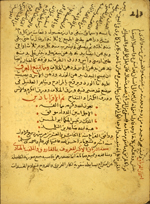Catalogue: Pharmaceutics
 Aqrabadhin (MS A 3/I, item 1)
Aqrabadhin (MS A 3/I, item 1)- (Formulary)
- كتاب القراباذين
- by Amīn al‑Dawlah Abū al‑ḥasan Hibat Allāh Ibn al-Tilmīdh (d. 1165/560)
- امين الدوله ابو الحسن هبة الله ابن التلميذ
A formulary of compound remedies consisting of twenty chapters. According to the introduction, it was based on a number of formularies and abridged by Ibn al-Tilmīdh for use in the ‘Adudi hospital in Baghdad.
For other copies, see GAL, vol. 1, p. 642 no. 18, GAL-S, vol. 1, p. 891 no. 18; Ullmann, Medizin, p. 306; Iskandar, "Wellcome", p. 78, MS. Or. 9; Dietrich, Medicinalia, p. 231-2; London, British Library, OIOC, MS Or. 8293, copied in 1228/625; Cairo, Dar al-Kutub, MS tibb 1212 and MS tibb 141 item 3; and Oxford, Bodleian MS Marsh 537 item 10, folio 182b-226b).
Aqrabadhin (MS A 3/I, item 1)
Illustrations
The colophon of a copy of the formulary (Aqrabadhin) by Ibn al-Tilmīdh (d. 1165/560). It is stated in lines 15-16 that the copy was completed on 25 Rabi‘ I 902 (= 1 December 1496). The copyist is not named. The bottom three lines constitute the beginning of an anonymous essay on the production of theriac (tiryaq). The marginalia apply to the latter treatise rather than to the formulary by Ibn al-Tilmīdh.
A portion of the formulary (Aqrabadhin) by Ibn al-Tilmīdh (d. 1165/560). The copy was completed on 25 Rabi‘ I 902 (= 1 December 1496), but the copyist is not named. In the right-hand margin the copyist has added a variant reading which he states was in another copy to which he had access.
The binding of the volume incorporates the covers from a 15th-century binding made in Egypt/Syria or possibly Persia. The central design of each cover is a scalloped mandorla. The points of the mandorla have extended gilt lines with tiny flower heads, and the edges of the mandorla have been painted gold, with gold radiating lines. The field within the mandorla has a blind-stamped floral and leaf design. The frame consists of a single gold fillet with tiny gold flowerheads at the corners, enclosed by a blind-tooled frame composed of lines either side of a row of small circles.
Physical Description
Arabic. 66 leaves (fols. 1b-66b, line 16). Dimensions 17.2 x 13.1 (text area 11.6 x 8.3) cm; 19 lines per page. The title is taken from the beginning of the table of contents (fol. 1b, line 2) and from the colophon (fol. 66b, line 10). The author's name is given on fol. 1b, line 2, as Amīn al-Dawlah and in the colophon, fol. 66b, lines 12-14, as Amīn al-Dawlah Abū al‑ḥasan Hibat Allāh Ibn al-Tilmīdh.
The copy is dated in the colophon (fol. 66b) 25 Rabi‘ I 902 (= 1 December 1496). The copyist is not named.
The text is written in a small to medium-small naskh using black ink with headings in red. The text area has been frame-ruled. There are catchwords.
There are marginalia in several hands, including marginal corrections and a number of recipes. The folios have been numbered by a later hand in Coptic numerals; the volume has been recently refoliated in pencilled Western numerals.
The thick biscuit paper has very indistinct vertical laid lines and traces of chain lines, possibly in groups of 2's. The paper is soiled through thumbing and damp-stained. The edges have been trimmed from their original size, occasionally cutting off marginalia.
The volume consists of 69 leaves. Fol. 1a has an extensive note in a later hand, concerned with giving instruction to physicians to use a certain compound remedy for specified complaints. Item 1 (fols. 1b-66b) is the formulary by Ibn al-Tilmīdh here catalogued; item 2 (fols. 66b, bottom -69b) is an anonymous discourse on tiryāq (MS A 3/I, item 2).
Binding
The collection of two treatises is bound together with another manuscript that is considerably older. The 8 leaves of MS A 3/II had separate foliation in Arabic numerals and are considerably older that the manuscript here catalogued with which it is bound; were the volume to be foliated straight through, then the eight leaves constituting MS A 3/II and one end leaf would be counted as fols. 70-78 of the bound volume.
The binding of the volume incorporates the covers from a 15th-century binding made in Egypt/Syria or possibly Persia. The central design of each cover is a scalloped mandorla. The points of the mandorla has extended gilt lines with tiny flower heads, and the edges of the mandorla have been painted gold and there are gold painted radiating lines. The field within the mandorla has a blind-stamped floral and leaf design. The frame consists of a single gold fillet with tiny gold flowerheads at the corners, enclosed by a blind-tooled frame composed of lines either side of a row of small circles. The spine and edges are brown leather replacements. The pastedowns and endpapers are modern.
Provenance
The volume was purchased in 1941 by the Army Medical Library from A.S. Yahuda, who acquired it from a dealer in Mosul in Iraq (ELS no. 1750; Med. 51).
References
Schullian/Sommer, Cat. of incun. & MSS., entry A3, pp. 297-8.
Hamarneh, "NLM", p. 95.
NLM Microfilm Reel: FILM 48-110 no. 3.













